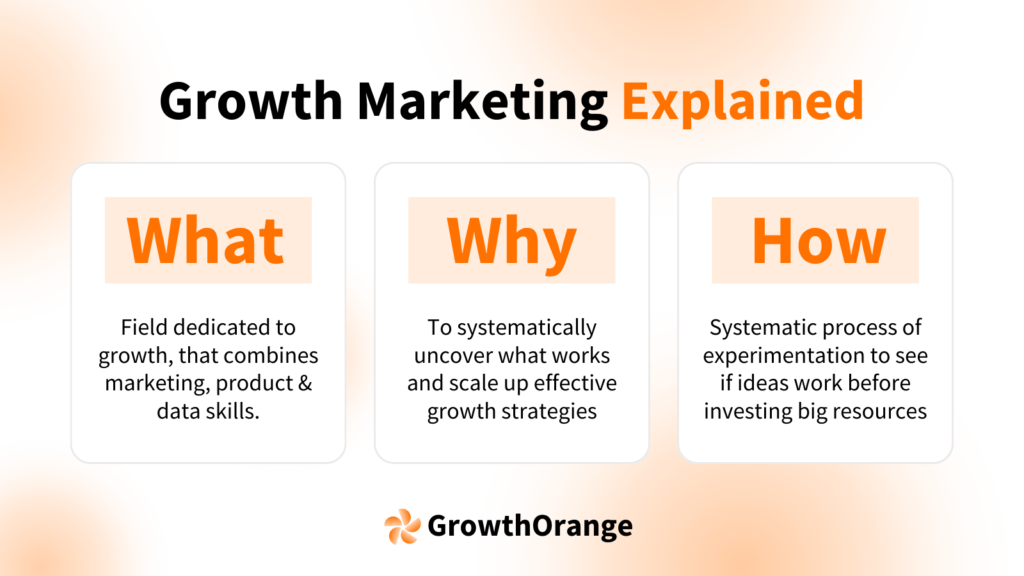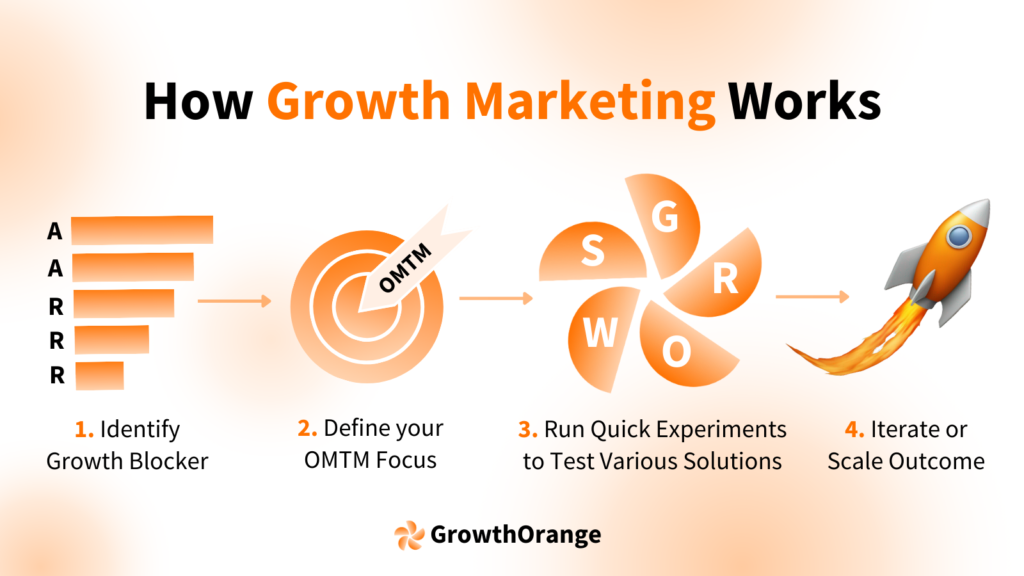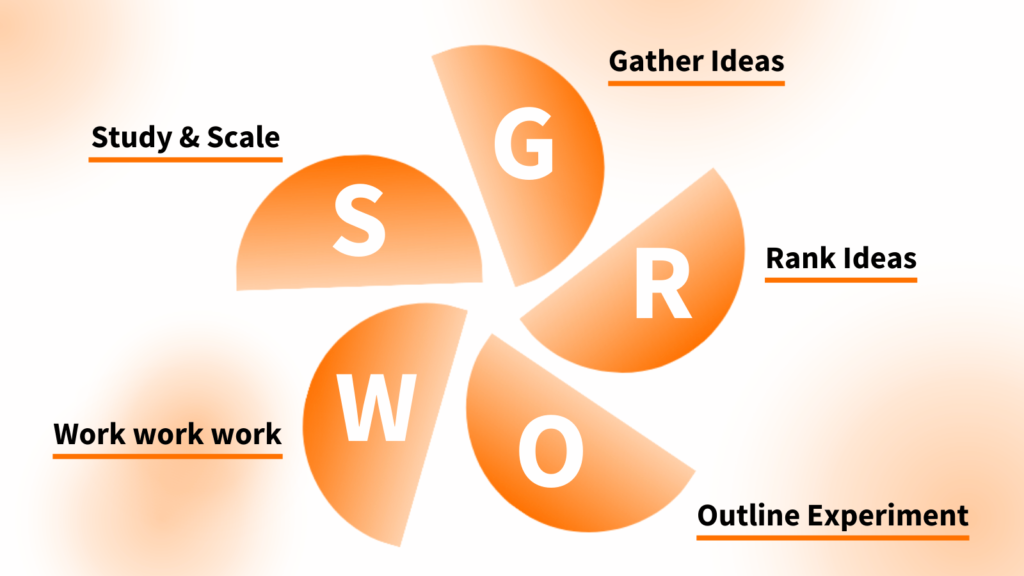Growth Marketing (also called Growth Hacking) is a systematic approach to achieve sustainable growth, focused on rapid learning and iterative processes. The core idea is to continuously experiment, measure, and optimize strategies to uncover the most effective ways to grow a business.
Despite its name, Growth Marketing goes beyond traditional marketing channels and involves product development, customer experience optimization, and data analysis.

How Growth Marketing Works
What Does a Growth Marketer Do?
A growth marketer should be central in the cycle of testing new strategies: first identify what is stopping your growth through data analysis, then brainstorm solutions, prioritize them and execute them quickly, and scale up what works. This is all part of the growth marketing process that we explain after this, called the GROWS Process. Their work often involves cross-functional collaboration, touching on product enhancements and customer experience improvements, so despite the name they do a lot more than just on the marketing side.

First, Find Your Growth Problem Through the Pirate Funnel
The Pirate Funnel (AAARRR: Awareness, Acquisition, Activation, Retention, Referral, Revenue) splits a company in six chronological steps to identify where the business can improve. Each stage of the funnel is analyzed to find the most significant opportunities for growth, and narrow down on the step that is stopping your growth the most.
Second, Pick Your OMTM as your Focus
The One Metric That Matters (OMTM) is a single, crucial metric that a business focuses on to drive growth. For example, for a B2B SaaS company, the OMTM could be the conversion rate from free trial to paid subscription as the main metric to improve.
Then, Run & Repeat the G.R.O.W.S.-Process
- Gather Ideas:
Collect data and brainstorm potential growth experiments. For instance, look at user feedback, conduct user interviews, and analyze website analytics to identify areas for improvement. - Rank Ideas:
Prioritize ideas based on potential impact and ease of implementation. Focus on experiments that can yield the highest returns quickly. For example, improving the onboarding process might have the highest impact because it addresses a critical stage in the customer journey. - Outline Experiments:
Design detailed plans for each experiment. Define the goals, hypothesis, and metrics for success, but make sure to keep it small, since this experiment might fail, so don’t put too much resources in at once. - Work:
Execute the experiments. Implement changes, track progress, and ensure proper monitoring. - Study Results:
Analyze the data to determine the success of each experiment. Use insights to refine and scale successful strategies. And each experiment might teach you something about your audience that you (or a colleague) could use in a different place.
And then you keep repeating this GROWS Process week-over-week until you’ve cracked the code and really improved your OMTM. And then every 2-4 months you’ll redo your Pirate Funnel analysis to pick a new growth focus.

Hypothetical Example: How To Apply Growth Marketing in a B2B SaaS Company
Imagine a B2B SaaS company which offers cloud storage solutions. The company wants to increase its user base and conversion rate from free trials to paid subscriptions.
Using the Pirate Funnel, they identify that while acquisition is strong, activation (getting users to start using the service) is weak. They decide to focus their OMTM on improving activation rates.
Following the GROWS process:
- Gather Ideas: They brainstorm several ideas, such as a guided onboarding process, adding tooltips to the user interface, and implementing a welcome email series.
- Rank Ideas: The guided onboarding process is prioritized due to its potential high impact and relatively low implementation cost. This idea is chosen for the first test.
- Outline Experiments: They design an experiment to test the onboarding process on a smaller scale. New users receive a step-by-step onboarding tutorial, and only 10% of the new users are included in this test group.
- Work: The onboarding tutorial is implemented for the test group. Progress is tracked, and the activation rates of users who received the tutorial are compared to those who did not.
- Study Results: The data shows a 25% increase in activation rates among those who received the tutorial. Additionally, they discover that users who engage with customer support within the first week are more likely to convert, so they implement proactive customer support engagement across other parts of the customer journey.
Each sprint/month the growth team will be running more experiments across the customer journey and slowly improve multiple growth blockers. When something is successful, it’s adopted by the day-to-day operations teams from marketing, sales or product to double-down on winning techniques.
Checklist: Is Growth Marketing Right for Your Business?
Before you dive right in, make sure that your company is ready for more growth.
- Do you have some Product/Market-fit?
If your product is already seeing some traction, from your manual labours, growth marketing can amplify its impact and scale up. Otherwise, it might be better to get yourself a marketer, sales or innovation team to first figure out how to market your product in the first place. - Can you move resources from daily operations to continuous testing and optimization?
See it as Research & Development department; Growth marketing requires time and resources to run experiments and analyze results effectively. Expect that not every experiment will be a success, so be prepared for a few months before you start to see results, but it does build to compounding interest over time and growth will get faster and faster, and will overtake any other department that is also busy with day-to-day activities. - Do you aim for scalable and sustainable growth rather than short-term wins?
This approach focuses on long-term growth by building a loyal customer base and improving lifetime value. For short-term wins, we’d advise to look more at paid marketing agencies.
Best Resources for Learning or Applying Growth Marketing
Growth Marketing Blogs to follow in 2024
- GrowWithWard.com, by Ward van Gasteren
- GrowthUnhinged, by Kyle Poyar
- GrowthMethod.com, for many fundamental definitions
- GrowthHackers.com, the largest Growth Hacking forum, founded by Sean Ellis
- Slightly more advanced:
Books about Growth Marketing
- Hacking Growth by Sean Ellis and Morgan Brown
- Growth Hacker Marketing by Ryan Holiday
- The Secret Sauce by Vincent Dignan (very practical book)
- And many more: on my personal blog I’ve made a list of the 23 most important growth hacking books if you want to learn more about growth marketing.
Courses on Growth Marketing
- CXL, Growth Marketing Degree – $1392 – Best in General but expensive
- GWW, 2024 Full Beginner Course – $299 – Best for Beginners
- Reforge, Growth Series – $1999/year – Best Advanced
Conclusion: Growth Marketing is a Systematic Approach to Growing a Business, through Quick, Data-Driven Experimentation
Growth marketing is a powerful approach for businesses looking to achieve rapid and sustainable growth through innovative, data-driven strategies. By focusing on critical metrics and continuously testing new ideas, companies can optimize their marketing efforts for maximum impact.
FAQs
Growth marketing is a data-driven approach focused on optimizing customer acquisition, retention, and expansion through continuous experimentation and testing.
Growth marketing emphasizes experimentation and data analysis, whereas traditional marketing often relies on broader, less-targeted campaigns. It also involves product development and customer experience enhancements.
A growth marketer uses innovative, low-cost strategies to help businesses acquire and retain customers, leveraging skills in marketing, data analysis, and product development.
Recommended resources include books like “Hacking Growth,” online courses from CXL and Udemy, and blogs like GrowthHackers.com and Neil Patel’s Blog.


